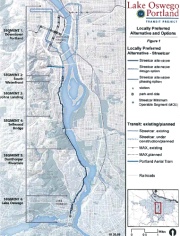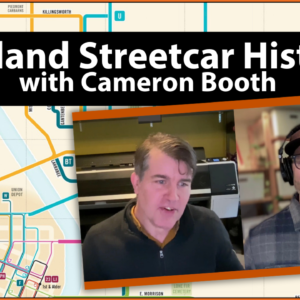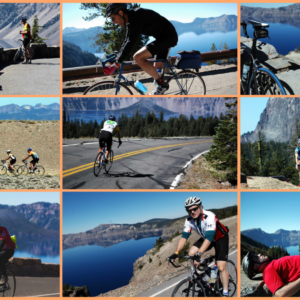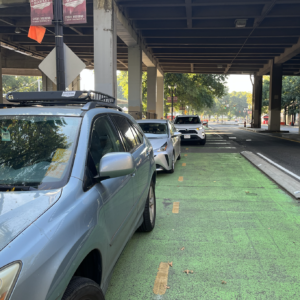
become a bicycle highway?
(Image: Metro)
After what the Oregonian called “persistent doubts from suburban taxpayers and a wealthy enclave of homeowners” the Lake Oswego streetcar project is on the rocks.
Concerns about construction and operating costs of the streetcar were the reasons for its demise, but over $2 million has already been spent on planning and impact studies.
Instead of throwing that money out the window, officials have an opportunity to build on the previous momentum for the streetcar and construct a world-class bike connection between Lake Oswego and downtown Portland.
Anyone who rides a bike between Portland and Lake Oswego knows that current options are lacking. Biking along Highway 43 is unpleasant and unsafe (Clackamas County might be improving bike access on it, but it won’t be game-changing). Other routes between the two cities’ downtowns are circuitous and include significant altitude gains.
Proposed routes for the streetcar have already been identified and the costs of building right of way along Highway 43 are known. The route identified for the streetcar would, obviously, be at an even grade and provide a direct connection for bicycles where one currently doesn’t exist.
I’ll be the first to point out that I’m not an engineer, but I think it’s safe to assume construction of a paved path would be cheaper than construction of train tracks. Maintenance and operating costs are also likely to be lower for a bike path than for the streetcar.
“The [streeetcar] route is perfect for a bike connection, isn’t it? Rail grading. Never more than 100 ft above the river. Awesome.”
— BikePortland reader Graham Ross
Some people might suggest the plan for a new connection between Lake Oswego and Portland should be scrapped completely to save tax payers’ money, but doing nothing would cause the region to miss out on a source of jobs and future revenue.
The streetcar line was the vital connection to the planned Foothills redevelopment district near the Willamette River and downtown Lake Oswego. Future development in the area was projected to bring in more revenue (in the form of property taxes) than it would cost to construct the streetcar. Development of the district and construction of the streetcar were projected to create as many as 6,000 new jobs.
Without the link provided by the streetcar the Foothills redevelopment project might be scrapped, along with revenue and jobs it would have created.
Constructing a bicycle corridor along the proposed streetcar route could help provide the transportation connection needed for redevelopment and would preserve revenue and jobs that come with it.
The possibility of using the streetcar route for a bikeway is already on people’s minds. BikePortland reader Graham Ross contacted us saying he doesn’t understand why there hasn’t been more public discussion about it already (emphasis mine):
“I’ve biked 43 both ways, which sucks, and I’ve climbed the Terwilliger and cemetery hills, which are lovely but strenuous. I know LO [Lake Oswego] is chock full of avid cyclists who work in Portland…The [streeetcar] route is perfect for a bike connection, isn’t it? Rail grading. Never more than 100 ft above the river. Awesome.”
Now the idea is officially out in the open.
Will officials seize the opportunity to build a world-class bike facility and foster economic development in our region? Or will they pass on the chance and leave the Foothills in the lurch?







Thanks for reading.
BikePortland has served this community with independent community journalism since 2005. We rely on subscriptions from readers like you to survive. Your financial support is vital in keeping this valuable resource alive and well.
Please subscribe today to strengthen and expand our work.
We discussed this issue at length over at Portland Transport, and the conclusion was that this ROW cannot be turned into a bikeway. Apparently, the easement only allows rail. If the rail is torn up, the easement goes away.
It is unfortunate, and who knows, maybe they will find a way around it. I think this would be much better used as a bikeway, although I would expect just as much opposition from the Dunthorpe residents, who don’t want the unwashed masses riding past their houses in a train or on a bike.
There is a process called ‘railbanking’ where a trail is built, but the option to return the tracks to service is still on the table.(they could keep the tracks underneath the trail path). I wonder if this would still meet the requirements of the easement.
So they just lay down asphalt over the tracks? Or the tracks need to be embedded in the trail? Do you have any links?
Here’s a summary of railbanking info:
http://www.railstotrails.org/ourWork/trailBuilding/toolbox/informationSummaries/railbanking_whatandwhy.html
A report from Vermont mentions the ‘filling’ technique:
http://www.aot.state.vt.us/progdev/Documents/LTF/FinalPedestrianAndBicycleFacility/Chap6.pdf
from p15
“The preferred technique that has been used in Vermont is to bring in fill sufficient enough to cover over the ties and rails. … This technique should be viewed as a short-term stopgap measure only. The major disadvantage of this approach is that the rail-trail is more prone to washouts and exposure of the under-maintenance. However, such a compromise may be necessary to obtain local and political support for development of a rail-trail. It should be noted that any remedy that calls for filling in and around the ties and rails will accelerate the deterioration of the ties and rails. The maintenance costs and benefits should be fully weighted before selecting either of these options.”
Your second link is bad but I found it:
http://www.aot.state.vt.us/progdev/Sections/LTF%20Info/DocumentsLTFPages/FinalPedestrianAndBicycleFacility/Chap6.pdf
I kinda like the idea of getting a mat of that recycled tires and shoe stuff that is often used for running surfaces. Might want to add some fine granite gravel to the granular rubber mix so that it provides wet traction.
Nike could fund it for PR points.
I’d suggest that the mat be of a thickness that it will not structurally fall apart when the grooves are cut out so that it fits right over the rails like a lego block.
I have heard that the RR right-of-way was preserved for future rail operations (streetcar or other) and that a covenant prevents it from being used otherwise.
Have not been able to independently confirm this.
A bike/pedestrian path to Lake Oswego would be great. However, this would require “abandoment” of the current train tracks and removing the historical trolley (which runs seasonally), to replace the tracks with a trail, at a cost of somewhere around $0.5million per mile. If we want to build a whole new path next to the train tracks, I would expect costs aroune $2 million per mile based on other projects (e.g. Sullivan’s gulch) – if it would fit in the narrow right-of-way or next to a public street right-of-way.
Would the rich folks along the route want a bike path instead of the tracks? If so, it could be easy politically. But if they are opposed to a path like they opposed the train, it could be a big NIMBY problem.
The two posters at the top have this right, you can’t replace the tracks with a trail because of ROW issues, the city would lose the easement.
If the citizens of Lake Oswego are dead set against using this for rail, let’s do it. Otherwise, it’s reserved for those who like walking old railroad tracks, and have flashlights.
The route is currently a disused railroad right-of-way, with existing tracks. Costs of a new trail would include removing the rails, paving, signage, and probably lighting, at least in the quarter-mile tunnel at Elk Rock.
Ok given the above issues – how about dusting off an old idea – installing bidirectional narrow gauge rail for public rail bikes ala 1890?! Portland always loves to transportation innovate. 🙂
Hotchkiss Railroad 1890s
http://nj-pine-barrens.livejournal.com/2557.html
Chris, is there a link to info about the “easement for rail only” issue? On Google Maps it looks like the right-of-way is a separate tax lot, everywhere except for a 2 block section, though it is only about 20 feet wide. Didn’t Metro or Trimet value the right-of-way at $80 million? I wouldn’t think an easement alone would have that kind of value
Maps:
Right-of-way: http://g.co/maps/6kn8s (thin gray lines show property boundaries)
Area with no right-of-way: http://g.co/maps/npmn8
If, in fact, it can only be used for rail, we should keep the historic trolley running, and eventually plan for a connection from MLR using the railroad bridge for light rail: http://g.co/maps/qhu88
And there is another threat to this route – I have read (somewhere) that there is a proposal to stop paying the rent on this ROW now – due either to budget issues or policy (anti streetcar) issues.
We need connections linking ppl in a safe and meaningful way. I have biked from Wilsonville to Portland and LO part is harsh at time upper boones rd
While I still hope this will eventually become a streetcar alignment, I think it could be killer bike/ped trail (if the right-of-way issues could be resolved).
However, I would note that the folks in Dunthorpe who have helped foment a lot of the opposition to streercar might work even harder to block a multi-use path.
Did you hear that smack? That’s Mr. Smith’s correct reasoning why the original plan fell through. The folks in Dunthorpe, where the trolley tracks runs across the end of their driveway, had enough money to influence the city council of LO. Pretty sure if they don’t want a trolley going across ROW at the end of their property, they won’t want the general public their either. Call it a NIMBY issue in regards to privacy of the landowner. Even though the ROW was in place before construction of those monster palaces even began.
*sigh* another example of people getting what they think they want instead of what smart people know that they need…
How ironclad is the covenant that prevents non-RR development on this line? If a MUP is the best and most desirable alternative we should pursue it. There must be a process by which the original contract could be amended? This opportunity is huge for riders like myself who are trying to get downtown quickly from LO as well as Portland riders looking to escape to here and parts south.
I would be hard pressed to think of another project that could open up so much potential riding for so many who don’t have a good LO to PDX option now. And then if we could open up the RR bridge from LO to Milwaukie…
I wish the BTA would make this their number one priority.
Agreed. Nearly everyone loves the springwater corridor and I think if you bundled up Sullivans Gulch, North Portland Greenway, the Red Electric path and this Lake O rail line into a big $150 million bond (or whatever the total cost is) and promoted them as new trails for everyone Portland voters would pass a bond measure to build them. Plus it gets around the NIMBY issues where you could point towards the will of the people.
That should be the BTA’s #1 goal in my mind.
Love your thinking Andrew! Sounds like a great idea to me… But you’ll have a wet blanket thrown around it very quickly by policy/politician types. They’ll say voters are too worried about the economy to approve something like that. I agree with you though.. This is exactly the type of thing I’ve been hoping for for years but no one in Portland region has had the guts to move forward with. It’s sad but true.
As the editor of the site you should be the first person to understand why the Lake O MUP can’t be built. As mentioned several times above, if the rails don’t get used then the easement disappears, and the property reverts to the adjacent property owners. The adjacent property owners have been obstructionist to the extreme, so there’s no realistic way that the MUP is ever going to be built.
This is not entirely accurate. Portions of the alignment are owned by the public and other portions are still owned by the adjacent property owners with a rail-only easement. These easement segments can be converted to public ownership for use as a MU trail through eminent domain. Eminent domain is not the most popular option but it is a valid public tool that is used often.
Great idea!
“open up the RR bridge from LO to Milwaukie”
My God that’s brilliant. If only…
Metro has tried to get this to happen for years. The RR companies are the obstacle…as always
RR company, singular. That RR bridge is owned by Genessee & Wyoming, a New York state holding company which wholly owns the Portland & Western RR and a couple dozen other short line railroads around the world.
If a bikeway is out of the question, how about a ferry boat between the Foothills and Waterfront Park at the Hawthorne Bridge?
Wouldn’t a ferry just be slower than throwing your bike on the 35 and taking that downtown?
Would be nice if they at least added a bikeway in the segment b/w lake o and the sellwood brige. That way from lake o you could cross over the Sellwood and connect to the springwater to get to NE or cross river again to get downtown.
Can’t you add a path next to the existing rail similar to the springwater? That way when gas prices go through the roof in a few years you can still add the streetcar?
Some of the right-of-way does not look wide enough to fit an active rail line next to a path. We might need to buy adjacent land in a few places or use boarding street right-of-way, which would be a pain:
Right-of-way: http://g.co/maps/6kn8s (thin gray lines show property boundaries)
Don’t be too quick to write-off the possibility of Railbanking these easements, and building a trail. The Rails-to-Trails conservancy has some good information on their website how this works. The following is clipped from their website:
“Established in 1983 as an amendment to Section 8(d) of the National Trails System Act, the railbanking statute allows a railroad to remove all of its equipment, with the exception of bridges, tunnels and culverts, from a corridor, and to turn the corridor over to any qualified private organization or public agency that has agreed to maintain it for future rail use.”
Easements specific to rail use are therefore maintained, as the trail serves as a method of maintaining and preserving the right-of-way for future rail use. In 1990 the U.S. Supreme Court upheld this very practice.
That’s good information. How can we find out if this would work in this situation?
Maybe people could take the rail and make it their own vehicles like Cambodians in this article I read in the Smithsonian magazine:
http://www.smithsonianmag.com/people-places/Catching-the-Bamboo-Train.html
This was also done my communities along an old (1890s) railroad in the Philippines when i lived there in the 1990s.
Here is a USA vendor of rail bike parts – see photos
http://www.railriders.net/pictures.html
How are the covenants covering this line different from other railroads? Don’t a lot of rail lines operate on easements over others’ private land? And don’t a lot of those still manage to get converted to rail-trails after they fall into disuse?
I know it’s not easy to do this (as evidenced by the veerrrrryyy looonnnggg process of getting rail-trails approved, such as recently happened with the lovely Klickitat Trail), but is this line really unique in that respect?
I think Chris Smith is right that Dunthorpe people will oppose a trail even more ferociously than they opposed the streetcar. This happens with ALL rail trails — property owners oppose the trail fiercely at first, citing threats of vandalism, illegal camping and various other crimes it allegedly will bring. And then by the time the trail is finally built, they brag about how great it is to live next to it — especially in their real estate flyers when it comes time to sell!
I have little sympathy for the property owners regardless of whether it turns into a trail or a slow, overpriced rail connection. They purchased their fancy properties knowing full well there was a transportation easement across them, and in any event it’s likely to increase rather than decrease their property values.
Agreed, but know that at the same time they purchased their properties, folks they talked to undoubtedly told them that as soon as they could force the city to abandon the trolley line, that bit would get added back to their properties.
I have always been shocked that this doesn’t already exist. A high quality trail along the Willamette would provide a perfect north-south bicycling corridor and be beautiful recreationally. I cannot think of a more important project.
Doesn’t a private streetcar company already own and use that alignment?
This is interesting – from the minutes of a City of Portland Pedestrian Advisory Committee meeting (2007), in a briefing from PBoT staff:
“…the Willamette Shore Line (WSL), an old railroad line owned by a consortium of governments (which includes the city of Portland), bought for future rail transit use. Today the line is used for an excursion trolley service operated by a non-profit organization. TriMet and the City of Lake Oswego maintain the tracks. Once bought for $2 million, today the WSL has a value of $75 million, which can be used to help pay for the local share of funding for the streetcar…
Q: Is there a possibility that the WSL could be used for trail only?
A: That is one of the things we are looking into. Currently, property owners have agreed in their deeds that the WSL can be developed, but only for rail use (there are several properties that straddle the shoreline). We are looking into the feasibility. We may work out an agreement with the property owners”
They don’t own it, although they did use it. Unfortunately I don’t think the trolley has been running for the last year or two.
Per their Facebook page, the Willamette Shore Trolley is scheduled to start seasonal operations again this spring.
The Willamette Shore Trolley uses the existing track to provide seasonal historic streetcar service, but the alignment is not owned by them:
“After passenger service was terminated, freight service continued until the 1980’s when the line was purchased by a consortium of government agencies to preserve the right-of-way for future streetcar service.”
You can download the ordinance (160998) authorizing the Willamette Shore Trolley at the following:
http://efiles.portlandoregon.gov/webdrawer/rec/2484082/
While I am not a legal expert, the passage in Section 6 on page 5 seems to say Portland could change the use of the rail line if Portland wants to divest and no govt. body is interested in taking over:
“If neither Tri-Met nor ODOT accepts the offer Portland may sell, dispose of or change the use of the right-of-way in Portland’s sole discretion.”
Could someone smarter than I read this and tell us what it says in non-legalese?
I can hear the cries of “Stop the Crime Path” already. It’s a great idea and I hope the ROW issues can be solved.
Why build on the rail when Highway 43 is already built. Put in some jersey barriers, dedicate a lane to bikers going either way, and call it a day. The increased bike traffic will reduce the need for two lanes of cars.
Peak oil (which will start to make the cost of oil unsustainable and volatile rather soon) here folks, we have a few decades left of automobiles as a primary mode of transportation.
Unfortunately, I doubt Peak OIl is going to get that many of the Lake Oswegans who commute on 43 out of their cars. I used to live along this line, and the demographics of OR 43 are not like those of most roadways in Portland.
Yep – the 1% there will have 99% of the last oil and continue driving until then.
The fun part about that is that when oil becomes that expensive gas stations are no longer a profit business no matter what the rich customer will pay because there aren’t enough customers.
The amount of gas stations in America only survives because of the volume of customers.
This means there will be fewer gas stations; probably less per capita than public charging stations now.
What this means to the rich is that from a practical standpoint they will need to keep a supply of fuel at home.
So if you want to really stick the knife in and twist it make sure to get a law passed that makes it impossible for non-agricultural users to get environment approval to install a large fuel tank.
This will be easier to pass while the rich have no clue they might want it.
Detailed maps of the legal issues with the alignment exist…ask Metro for a peek. They might reluctanly print off some copies with a public request.
Don’t forget, the original projects was a Rails AND Trails project. The trail was dropped because of the Dunthorpe tunnel and other engineering problems within the ROW. There is no way to have both streetcar and multi-use trail within the ROW that is available for this project.
Legally, there is no way to create a Trail project alone. The ROW has been set aside for transit only…if not transit than the ROW is revocable. And, the easements are not the same for each parcel…there are something like 8 or 10 easement types along the ROW. Some are fully revocable, while others are partially.
It is a mess and the legal team and planners at Metro never wanted to confront the issues during the planning phases. It is well known that there are issues…but, not exactly what the options are. They don’t even know if the easements might ‘expire’.
There was very little public support for the Streetcar…the folks along the alignment also stated that the alignment would never become a multi-use trail.
It is a great idea…but, Lake O, Dunthorpe and Riverdale don’t hire lawyers..they are the lawyers.
Good Luck
~ginseng
I would love to see the state build a rail bridge just south of the Sellwood connecting this line to the Springwater line up to OMSI. Then they could run passenger and freight trains past these houses, legally.
I think what might actually get some Lake Oswegans out of their cars, is if there is a world-class bike path along the river that lets folks get a pleasant workout – either on weekends with their kids in tow, or on a relatively flat and auto-free scenic commute to and from Portland. As a resident of Lake Oswego, I understand the glib comments about the 1%. Sure it exists here, but it also exists in Portland. Most of LO is part of the 99%. There are many condos in my neighborhood that sell for less that $90,000. We don’t all live on the lake and drive late model BMW’s. But we do all need to get some exercise to stay healthy. And if getting that exercise helps relieve congestion on 43 and gives folks a chance to celebrate their health and fitness in a constructive way, then so be it.
I know there are a lot of obstacles, both legal and political but the potential is so great. I think opening up this route could really increase ridership- especially for those living in hilly-and-curly-streeted SW. There are practically no flat, straight connecting routes for cyclists over here.
Keep in mind that from downtown to Marine Dr. is about six miles and from downtown to LO along the line it’s about 6.5. A lot of folks think nothing of riding that distance. But they probably wouldn’t even think about riding to LO now though because all the hills and piece-meal bike connections.
The east is lucky in being able to choose from a number of gridded and flat streets (from downtown basically all the way out to Gresham and from N PDX to outer SE) but this is probably the only good chance to add something equivalent coming this direction.
43 is simply constrained by geography. That road won’t be widened to allow reasonably safe biking. Any changes will be minor at best. I can’t think of a single other relatively flat, low traffic way to leave PDX toward outer SW/LO/West Linn/Tualatin. The fact that there is any option at all seems like something worth pursuing. If the opportunity passes the best you could hope for is marginally better conditions on 43 or sharing more traffic choked roads like Boones Ferry at present (not terrible but compared to riding in peace along the river..) It might help reduce the obvious problems with Barbur too. And fixing Barbur would definitely be expensive.
These kind of projects get done all the time- when automobiles are involved. I’m having a hard time accepting that it can’t be done now when it could be such a huge solution regionally and impact so many people. Can anyone speak to the possibility of using eminent domain in this situation? It seems like its use would be made easier by the easement situation rather than out-right taking what property is needed.
I know Metro and TriMet claim that this alignment can’t be turned into a trail because of rail easements. I say that’s BS. Why can’t Metro or another government agency condemn whatever pieces of the alignment have a rail easement to take clear title of the land? A few very good lawyers and a few million $$ can take care of this problem. I could give a rat’s ass about the rich SOBs this alignment goes near. Maybe they should’ve realized they were buying a property along a rail line before putting down several million $.
Listen people, especially those that aren’t involved in the process. You all need to know that “The Dunthorpe Group” has hired “Len” as their Washington DC lobbiest to kill the plans. They have spent hundreds of thousands of dollars on a “mis-information” campaign. For those not involved in transportation issues, it would seem that there’s a high level of ingorance and equally high level of opinion that is way off the mark. People…look at the Dunthorpe Group, look at those in that group and you will find your answers. The rail project is for this community to connect to the Regional Transportation Plan looking into the future…not right now…get it people. The “right of way” issues will go away and they will not come back. There will be a time in the future when the community will realize they made a major mistake. I’ve seen the numbers on the project, yes, it’s expensive but you can’t avoid the issues that corridor has now and into the future. As it stands, traffic flow on Hwy 43 is not far off of max allowable traffic and will not meet those requirements in the future. You and I can’t change that, it’s coming. Do you actually think Dunthorpe will let a path go through their back yards with people looking into their back yards? Just putting a RTT path won’t cost money? The tunnel, the other sections that must be improved to legally allow bike traffic will cost millions. For those outside the area, thanks for your opinions, but, spare us please. There are cyclists and there are people who ride bikes, which one are you? As much as I would love a RTT to Portland, it doesn’t deal with the issues in the future. I have lived on Riverwood Rd, so I know the neighborhood and it’s residents. I am also involved with City government. There is much more involved than these postings are dealing with. People, please, educate yourselves, don’t through out opinions just for opinion’s sake. This is a bigger issue than you think, I appreciate opinions from Bike Portland people and people who live in Portland, but, don’t follow your friend of the cliff. Come to meetings, do the research, and I mention again, look at “Dunthorpe Group”. Gee, can you imagine that someone might actually launch a campaign of dis-information to protect their own narrow minded issues? Go figure
That would be a fun thing for tourists. How many commuters would really want to pedal that far though? I can see some advantages over bicycles such as a covered roof and sharing the pedaling. Perhaps with a bunch of energetic cyclists they could compete for new time records… Sounds like fun and a good way to get around the using the rails problem.
nitpick, story should read “significant elevation gains” – “altitude” refers to distance above the ground, which most bicycles are not capable of.
I can’t believe 43 is still being used as a demographic isolater. Get with it already. Tear out unused tracks and replace with paved or decomposed granite trail, no brainer. . .
http://en.wikipedia.org/wiki/File:RailVelocipede.jpg
Velocipede on rails
This wouldn’t have to have heavy iron wheels, it could all be lightweight
I seem to remember that the land for the rails was donated for rail use only. If there is an attempt to change the use from rail to anything else, the land reverts back to the original owners estate. Then the current owners of the estate could use it for what ever they wish.
This rails-to-trails project is needed. Highway 43 has many near-crashes.
http://www.oregonlive.com/commuting/index.ssf/2013/11/joseph_rose_trying_to_make_sen.html